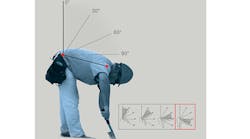NIOSH and the Canadian Center of Research Expertise for the Prevention of Musculoskeletal Disorders have released a new report to help EHS practitioners conduct observation-based posture assessments.
The report – “Observation-Based Posture Assessment: Review of Current Practice and Recommendations for Improvement” – describes a research-based approach to classifying the severity of torso and arm posture. The approach has been demonstrated to improve the accuracy and efficiency of workplace posture analysis, according to NIOSH.
The purpose of the document is to help EHS practitioners assess working posture for the prevention and control of occupational musculoskeletal disorders. Quantitative or semiquantitative descriptions of posture are inputs to many job-analysis tools applied in MSD prevention and control.
The report’s authors address enhancements such as the benefits of digital video, computer software, training and use of visual cues. The report also provides practitioners with tips for digitally recording and analyzing workers’ posture.
A few tips for recording and analyzing workers’ posture include:
- Record the task from multiple views and encourage the worker to avoid loose-fitting clothing.
- If possible, have one of those views be perpendicular to the plane of the joint movement.
- Zoom in on limb segments so that the joint of interest is as large as possible in the camera field of view.
“Overexertion injuries to muscles, bones or joints cost U.S. businesses billions of dollars each year,” said Brian Lowe, Ph.D., research industrial engineer and NIOSH author. “This report can assist practitioners by providing research-based and practical recommendations to improve their practice of posture analysis of workers who are at risk of injury from lifting, pushing, pulling, carrying or manual handling.”
